 Those of you familiar with
Capcom’s Rival Schools on the PlayStation know that it came seemingly out of nowhere
to become one of the most creative and fun fighting games on the system. The much delayed
sequel, Project Justice, has finally made its way to the U.S. It seems fitting somehow
that in the twilight hour of the Dreamcast it still effortlessly dominates the competition
by delivering the highest quality fighting games available, due in large part to
Capcom’s tremendous support. It’s like I’ve always said; you can always
count on Capcom to deliver the goods.
Those of you familiar with
Capcom’s Rival Schools on the PlayStation know that it came seemingly out of nowhere
to become one of the most creative and fun fighting games on the system. The much delayed
sequel, Project Justice, has finally made its way to the U.S. It seems fitting somehow
that in the twilight hour of the Dreamcast it still effortlessly dominates the competition
by delivering the highest quality fighting games available, due in large part to
Capcom’s tremendous support. It’s like I’ve always said; you can always
count on Capcom to deliver the goods.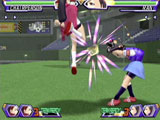 And Project Justice is, of
course, no exception. To the contrary, Project Justice epitomizes the Capcom style,
capturing the anime flare, flavor and over-the-top hyperactive action and weaving it into
a game that reminds us of all the great Capcom fighters we have seen over the years, while
still managing to stand out as a wholly unique game.
And Project Justice is, of
course, no exception. To the contrary, Project Justice epitomizes the Capcom style,
capturing the anime flare, flavor and over-the-top hyperactive action and weaving it into
a game that reminds us of all the great Capcom fighters we have seen over the years, while
still managing to stand out as a wholly unique game.
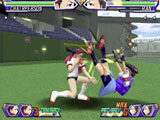 The story begins one year after Rival Schools. A series of unexplained
conflicts threatens to spiral out of control and send our group of heroes and heroines
into oblivion. Your job, no matter which school you choose, is to unravel the mystery and
save the day. This mystery can be solved in a variety of ways including, but not limited
to, providing beatdowns, smackdowns, brutal pummelings, or ass-kickings. Whichever method
you choose to unravel the subtleties of the mystery, the story will still be a hoot. There
are various branching paths to choose from, depending on which fighter you choose in a
particular battle, and new characters can be unlocked in this way. All roads lead to the
same confrontation in the end: a mean, mean, demon with a bad attitude and a mean streak.
On the down side, none of the dialog in any part of the game has been translated, and the
subtitles are rough and unpolished. Yet even this seems somehow to work for Project
Justice, giving it a nostalgic, genuine feel full of comic relief and the knowledge that
the story can't possibly be taken too seriously.
The story begins one year after Rival Schools. A series of unexplained
conflicts threatens to spiral out of control and send our group of heroes and heroines
into oblivion. Your job, no matter which school you choose, is to unravel the mystery and
save the day. This mystery can be solved in a variety of ways including, but not limited
to, providing beatdowns, smackdowns, brutal pummelings, or ass-kickings. Whichever method
you choose to unravel the subtleties of the mystery, the story will still be a hoot. There
are various branching paths to choose from, depending on which fighter you choose in a
particular battle, and new characters can be unlocked in this way. All roads lead to the
same confrontation in the end: a mean, mean, demon with a bad attitude and a mean streak.
On the down side, none of the dialog in any part of the game has been translated, and the
subtitles are rough and unpolished. Yet even this seems somehow to work for Project
Justice, giving it a nostalgic, genuine feel full of comic relief and the knowledge that
the story can't possibly be taken too seriously.
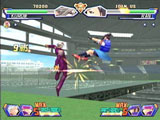 Let’s
face it. Fighting games are about skill, competition, and copious amounts of fun. The
story is there to add cohesion to the game modes and give an easy excuse for a sequel.
Even Soul Calibur’s much lauded story mode is more accurately described as a sequence
of incredibly well designed mini-games separated by a paragraph or two of inane text. The
most enjoyable story ever written in a fighting game has to be from Dead or Alive 2, where
the absolute absurdity of the incomprehensible text brought me much laughter and more
enjoyment than any number of Mortal Kombats or Street Fighter Alpha 2nd Chance
Turbo Remix 3’s. My point here, and I am going to arrive at one, is that I am willing
to look past story/translation issues if the gameplay is there.
Let’s
face it. Fighting games are about skill, competition, and copious amounts of fun. The
story is there to add cohesion to the game modes and give an easy excuse for a sequel.
Even Soul Calibur’s much lauded story mode is more accurately described as a sequence
of incredibly well designed mini-games separated by a paragraph or two of inane text. The
most enjoyable story ever written in a fighting game has to be from Dead or Alive 2, where
the absolute absurdity of the incomprehensible text brought me much laughter and more
enjoyment than any number of Mortal Kombats or Street Fighter Alpha 2nd Chance
Turbo Remix 3’s. My point here, and I am going to arrive at one, is that I am willing
to look past story/translation issues if the gameplay is there.
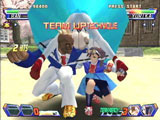 And
the gameplay is there. At the beginning of the game you choose three fighters. One primary
fighter and two support fighters that can be called in to provide various attacks on your
enemy, or help you out with healing or filling your power gauge. While tagging in a
partner to perform a special attack, the opponent may also tag in a partner to stop your
partner. The two secondary characters duke it out, and the first one to land a blow wins.
If your character wins, the special attack goes off as normal. If the opponent wins then
the attack has been successfully countered. It’s not as complicated as it sounds, but
it is a hell of a lot of fun moving at extreme speeds for fast paced anime style action.
At the end of the round you can choose to stay with the character you have, or tag out
with one of the two support characters.
And
the gameplay is there. At the beginning of the game you choose three fighters. One primary
fighter and two support fighters that can be called in to provide various attacks on your
enemy, or help you out with healing or filling your power gauge. While tagging in a
partner to perform a special attack, the opponent may also tag in a partner to stop your
partner. The two secondary characters duke it out, and the first one to land a blow wins.
If your character wins, the special attack goes off as normal. If the opponent wins then
the attack has been successfully countered. It’s not as complicated as it sounds, but
it is a hell of a lot of fun moving at extreme speeds for fast paced anime style action.
At the end of the round you can choose to stay with the character you have, or tag out
with one of the two support characters.
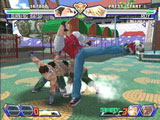 As
much fun as this all is, the real shinning light of Project Justice is found in its
amazing characters. The initial line-up of twenty characters provides a masterful variety
in speed, power, and size. What’s far more important is the variety in how the
characters look and feel. Each of the seven schools has a different vibe to it. From the
jocks who do combat with baseball bats and soccer balls to the deadly violin music of
Yurika or the picture snapping journalist/warrior Ran, Project Justice is brimming with
innovative, varied, and fun characters. This alone sets Project Justice well above the
competition.
As
much fun as this all is, the real shinning light of Project Justice is found in its
amazing characters. The initial line-up of twenty characters provides a masterful variety
in speed, power, and size. What’s far more important is the variety in how the
characters look and feel. Each of the seven schools has a different vibe to it. From the
jocks who do combat with baseball bats and soccer balls to the deadly violin music of
Yurika or the picture snapping journalist/warrior Ran, Project Justice is brimming with
innovative, varied, and fun characters. This alone sets Project Justice well above the
competition.
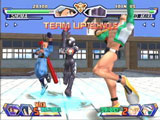 The
control on Project Justice is very good as well. It takes a little getting used to, but
ultimately the joystick on the Dreamcast controller becomes very intuitive and simple to
manipulate. There are a variety of relatively standard patterns that reappear throughout
the characters, so learning button and direction manipulation for special moves isn’t
very difficult. However, given the huge variety in characters, each one performs a unique
move and so the intricacies of each character must be mastered. The four basic buttons
represent two punches and two kicks, while the two shoulder buttons represent a sidestep
and a throw.
The
control on Project Justice is very good as well. It takes a little getting used to, but
ultimately the joystick on the Dreamcast controller becomes very intuitive and simple to
manipulate. There are a variety of relatively standard patterns that reappear throughout
the characters, so learning button and direction manipulation for special moves isn’t
very difficult. However, given the huge variety in characters, each one performs a unique
move and so the intricacies of each character must be mastered. The four basic buttons
represent two punches and two kicks, while the two shoulder buttons represent a sidestep
and a throw.
 This
looks to be a long dry summer for fighting games, especially for those poor souls without
a Dreamcast. Project Justice is the relief you need to make it through the long months
ahead. Frugal shopping will reveal many places retailing Project Justice for as little as
$19.99, making it one of the best bargains ever and skyrocketing it to the top of my
recommendations list. What’s more, Project Justice is one of the most creative
fighting games around, and true fans of the genre will want to check it out. Project
Justice is one of those rare games that succeeds in large part because it shows us
something more and different, and in so doing it shows us what we didn’t even know we
were missing.
This
looks to be a long dry summer for fighting games, especially for those poor souls without
a Dreamcast. Project Justice is the relief you need to make it through the long months
ahead. Frugal shopping will reveal many places retailing Project Justice for as little as
$19.99, making it one of the best bargains ever and skyrocketing it to the top of my
recommendations list. What’s more, Project Justice is one of the most creative
fighting games around, and true fans of the genre will want to check it out. Project
Justice is one of those rare games that succeeds in large part because it shows us
something more and different, and in so doing it shows us what we didn’t even know we
were missing.
